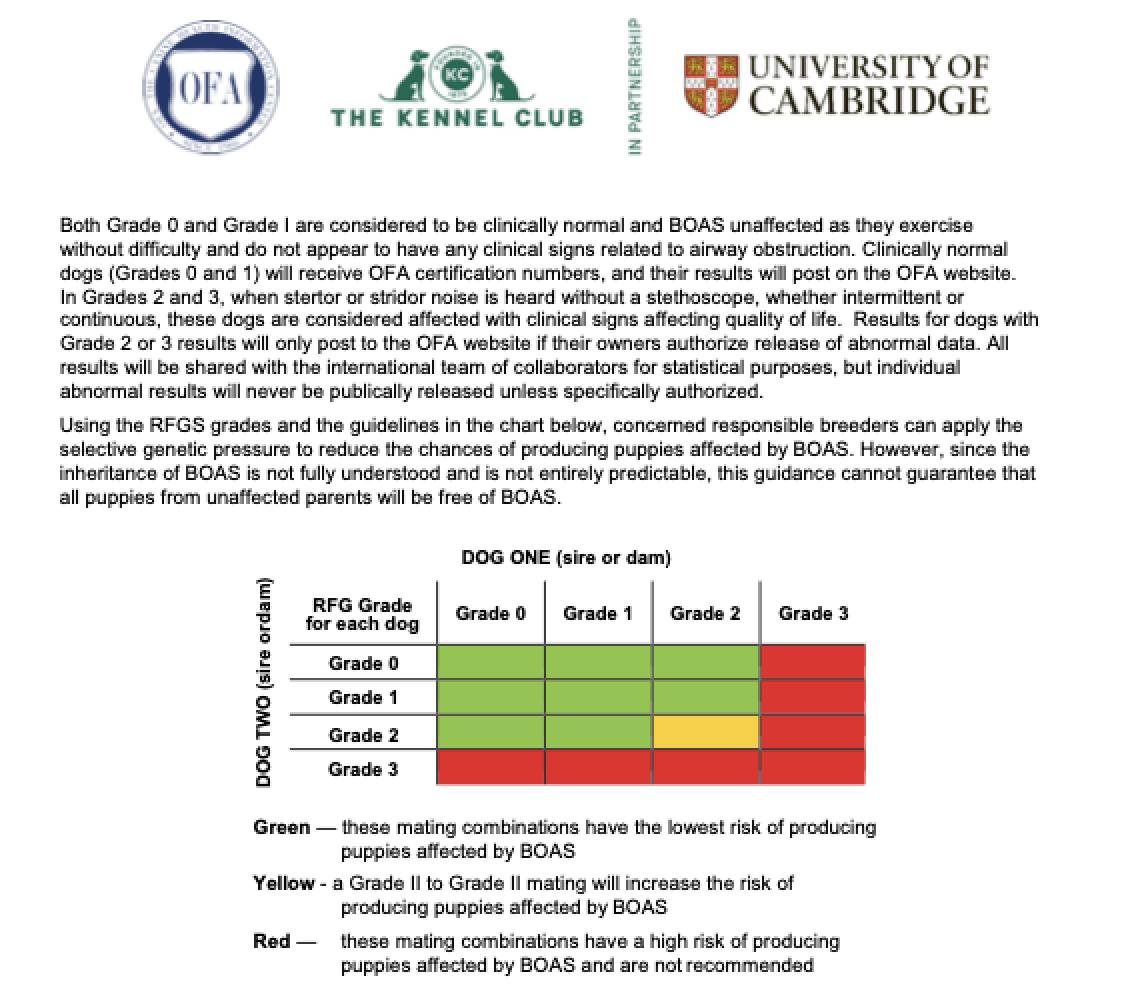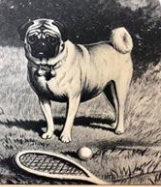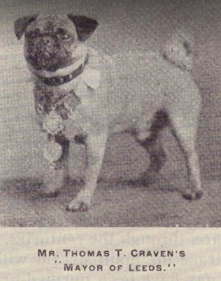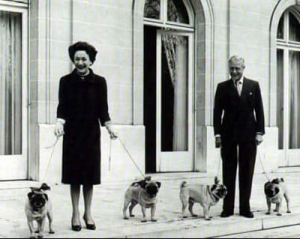569 – OFA Launches New Testing for Brachycephalic Breeds
OFA Launches New Testing for Brachycephalic Breeds

Dr. Kathleen Smiler, DVM, Pug Dog Club of America Health Committee Representative.
Eddie Dziuk, Chief Operating Officer at the Orthopedic Foundation for Animals, and Dr. Kathleen Smiler, DVM, Health Committee Representative from the Pug Dog Club of America, join host Laura Reeves to introduce the new BOAS testing program.
“Brachycephalic Obstructive Airway Syndrome (BOAS) is a condition which may cause breathing difficulties in breeds such as Bulldogs, French Bulldogs and Pugs,” according to the OFA. “BOAS is caused when the soft tissue in the nose and throat are excessive for the airway, partially obstructing the airway and making it difficult for them breathe normally.
“BOAS is a progressive disorder and can impair a dog’s ability to exercise, play, eat and even sleep. Clinical signs of BOAS are variable and may include noisy breathing, exercise and heat intolerance, regurgitation and dysphagia. Unfortunately, many owners are unaware of the disease, and often interpret breathing noises or difficulties as simply normal for the breed.
“In an effort to learn more about the condition, increase awareness, and ultimately reduce the incidence of BOAS, researchers at the University of Cambridge in the UK developed the Respiratory Function Grading Scheme (RFGS). The goal of the RFGS was to develop an objective test to measure the clinical diagnosis and severity of BOAS. The OFA has joined this international effort and has licensed the RFGS for use in the US and Canada.
“The exam is conducted by a specially trained and approved veterinarian and consists of 4 steps:
- A short health survey regarding the dog’s breathing history
- A brief physical exam while the dog is calm including auscultation where the assessor listens to the dog’s breathing with a stethoscope gently positioned on the side of the neck. This establishes a baseline for any clinical signs of BOAS.
- A short exercise test consisting of a brisk three minute walk. This is designed to expose clinical signs of the disease in an otherwise calm and asymptomatic dog. It is not designed to assess cardiovascular fitness.
- A post exercise auscultation after increased airway activity to compare to the pre-exercise baseline.”
“I think the veterinarians were extremely enthusiastic,” Smiler said of the veterinarians participating at a recent event in Portland, Oregon. “And I think the participants were quite pleased too, I think. I went and sat in the meet the breeds box with the pug people in Portland and everybody was quite satisfied. I think our club in general was very satisfied.”
“We examined 54 dogs (at the rollout in Portland),” Dziuk said. “We actually did 60 where we had a couple breeds that weren’t on the official breed participant list yet. So, we had 54 between Bulldogs, Frenchies and Pugs and we also had a couple of Bostons and Pekes.
“Overwhelmingly (we had) pretty good results. We had 10 Grade 0. So, the grade zeros are basically everything was good. These dogs were good breathers, they had nice wide open nostrils. There were no sounds of turbulence or anything during the auscultation, so everything was looking pretty good. We had 18 grade 1, which is also good. It means that in general, nothing could be heard without a stethoscope and you could only hear some of the minor issues with the stethoscope, but the dogs are basically still found to be clinically unaffected by BOAS. We did have 25 grade twos and we had one lone grade three.
 “I think that goes to prove the point that not all Bulldogs suffer breathing difficulties, not all Frenchies suffer breathing difficulties, and not all pugs do either. That there is a large group in all three of those breeds where they’re good healthy dogs that breathe fine, that don’t show signs of exercise intolerance, and we can work with those dogs and breed them and hopefully breed lots of future generations of good, healthy Frenchies, Pugs and Bulldogs.”
“I think that goes to prove the point that not all Bulldogs suffer breathing difficulties, not all Frenchies suffer breathing difficulties, and not all pugs do either. That there is a large group in all three of those breeds where they’re good healthy dogs that breathe fine, that don’t show signs of exercise intolerance, and we can work with those dogs and breed them and hopefully breed lots of future generations of good, healthy Frenchies, Pugs and Bulldogs.”
“We’re certainly very sensitive to the criticism that’s been directed toward brachycephalic breeds,” Smiler said. “I think we’re fortunate here in the US, where (breeding) isn’t a regulated activity, nor has the Veterinary Association attacked the breeds as they did in Europe. We’re going to make this information available to our members and highly encourage them (to participate). Then eventually I’d love to educate the puppy buyers. I think it’ll be very positive across the board.”
Listen in to the full episode for more details.
294 – Veterinary Voice: Brachycephalic Breeds’ Health and Legislation
Veterinary Voice: Brachycephalic Breeds’ Health and Legislation
Dr. Marty Greer visits with host Laura Reeves about the health and recent international legislation impacting Brachycephalic breeds.
Pugs In Holland

Pug circa 1879. Our thanks to PureDogTalk listener Kelly Schur for making these images available.
Recently the Dutch Pug Club announced, with immediate effect, that the breeding of any pug with a nose less than a third of the length of the skull has been banned.
The following information regarding the breeding of Brachycephalic dogs in Holland is gleaned from several Dutch websites using Google translate:
It has been against the law in Holland since 2014 to breed flat-faced dogs but the government has recently announced they will now be checking dogs, which has triggered this change.
The ban affects popular dog breeds. In the very short term, according to the Dutch legislation, the muzzle of the following dog breeds must be adjusted: French Bulldog, Pug, Boston Terrier, English Bulldog, Shih Tzu and Pekingese. In the longer term, targeted breeds also include the Boxer, Bordeaux Dog, Bullmastiff, Chihuahua, Cavalier King Charles Spaniel and the Yorkshire Terrier .
“It has actually been forbidden since 2014 to keep breeding short snouts, but the ministry has now announced that they will actually check it,” according to Milo Laureij of Dier & Recht. Dier & Recht is a lobbying group that advocates against purebred dogs, insists that wrinkles and flat faces are “harmful” to dogs and “Requires breeders to prevent hereditary disorders.”
Muzzle length
According to the new criteria from the Dutch Pug Club, the muzzle of a dog must be at least a third of the head. That means the end of the pug as it is now being bred in Holland, but also, for example, of the popular English and French Bulldogs and twenty other breeds.
End of breeding
For Commedia, the Dutch association of breeders of Pugs, the new policy is a reason to stop breeding immediately – before enforcement has come into effect. “Since the Ministry believes that breeding dogs with harmful external characteristics has been banned since the entry into force of the Decree on Holders of Animals (2014), we must also conclude that our internal regulations were in part in conflict with and this decision,” the breed club writes on its website.
New breeding program
“Together with the Expertise Center for Genetics Companion Animals, we are now going to put together a breeding program to find out how we can make the pug meet the requirements of the legislator within a number of generations,” said chairman Arjan Sterk. According to him, the breeders reacted differently to Commedia’s decision. “They all understand, but there is always anger and disappointment. But I have not heard that people drop out.”
Traffic light system
The ministry uses a traffic light system with the colors red, orange and green. Red applies to dogs with a snout length shorter than a third of the skull, such as the pug and English and French bulldog. Breeding with these dogs is prohibited immediately. Orange applies to dogs with a muzzle length of a third to half the skull. With this, breeding is only allowed if they meet other criteria that are set for breeding. ‘Green’ dogs have a snout that is at least half the size of the skull. You can breed with this.
Shock waves in U.S.

Pug circa 1910. Our thanks to PureDogTalk listener Kelly Schur for making these images available.
Greer noted that National Animal Interest Alliance (NAIA) is actively working to encourage awareness by breeders and purebred dog enthusiasts in the U.S. and elsewhere about this type of animal rights extremism and its looming potential impact here.

Duchess of Windsor’s Pugs … late 1800s. Our thanks to PureDogTalk listener Kelly Schur for making these images available.
Pugs are an ancient breed from China, the appearance of which has changed little in 150 years.
From the Pug Dog Club of America, “The Pug is of Chinese origin and dates back to the pre-Christian era. They were prized possessions of the emperors of China and lived in a most luxurious atmosphere and at times were even guarded by soldiers. Records show that three types of short-nosed dogs were bred by the Chinese. They were the Lion dog, the Pekingese and the Lo-sze. The Lo-sze or “Foo Dog” was the ancient Pug.”


